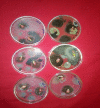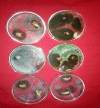Mycobiota profile, phenology, and potential toxicogenic and pathogenic species associated with stored groundnuts (Arachis hypogaea L.) from the Volta Region, Ghana
- PMID: 35311164
- PMCID: PMC8907750
- DOI: 10.1002/fsn3.2719
Mycobiota profile, phenology, and potential toxicogenic and pathogenic species associated with stored groundnuts (Arachis hypogaea L.) from the Volta Region, Ghana
Abstract
This study updates the mycobiota resident in groundnut seeds, their phenology during storage with the view to ascertain their occurrence, potential toxigenic species, and pathologically important species in the stored samples. The moisture content of the seeds ranged from 5.7% to 6.5% within the stipulated safe moisture content of 8% for extension of shelf life. Culturing the seeds on mycological media (Sabouraud's Dextrose Agar SDA; Oxytetracycline Glucose Yeast Extract OGYE, Potato Dextrose Agar, PDA) caused a de novo growth of the quiescent spores at 28-30°C for 7-14 days. Fungal population counts on the three media ranged from 2.01 to 2.16 log10 CFU/g samples to a final 6-month count of 1.67-2.60 log10 CFU/g. Eighteen different fungal species belonging to ten genera were encountered on the media, namely Aspergillus, Cladosporium, Curvularia, Fusarium, Penicillium, Trichoderma, Rhizopus, Rhodotorula, Sporendonema, and Paecilomyces. Aspergillus spp. (A. niger, A. flavus, A. fumigatus, and A. terreus) were the most frequently isolated, followed by Fusarium species (F. oxysporum, F. solani, and F. verticillioides), Trichoderma (T. harzianum and T. viride), Rhizopus spp (R. oligosporus and R. stolonifer), and Penicillium verrucosum. The species which were seed borne (A. niger, A. flavus, A. terreus, A. fumigatus, F. solani, F. verticillioides, T. viride, C. herbarum, and Curvularia lunata) were isolated on both surface sterilized and non-surface sterilized seeds. The phenology of the encountered fungal species generally followed five patterns. The most frequently isolated Aspergillus niger, A. flavus, and A. fumigatus predominated throughout the 6 months sampling period, while A. ustus and A. terreus appeared sporadically and disappeared. The early colonizers (R. oligosporus, R. stolonifer, and Paecilomyces) could not be isolated after 2-3 months owing presumably to stronger antibiosis competition from the Aspergillus species. The most predominant Aspergillus species initially constituted 36%-48% of the total population but declined to 10%-36% in 6 months. Mycobiota encountered with mycotoxigenic potential and human health importance were A. niger, A. flavus, A. fumigatus, F. verticillioides, and Penicillium verrucosum. Other species of pathological importance to plants were Curvularia lunata and Fusarium oxysporum. The practical implications of these findings are discussed.
Keywords: Fusarium and Curvularia species; Groundnut; Penicillium; mycobiota phenology; mycotoxicogenic and pathogenic Aspergillus.
© 2022 The Authors. Food Science & Nutrition published by Wiley Periodicals LLC.
Conflict of interest statement
The authors declare that they do not have any conflict of interest.
Figures





Similar articles
-
Fungal profile, levels of aflatoxin M1, exposure, and the risk characterization of local cheese 'wagashi' consumed in the Ho Municipality, Volta Region, Ghana.Toxicol Rep. 2024 Jan 17;12:186-199. doi: 10.1016/j.toxrep.2024.01.009. eCollection 2024 Jun. Toxicol Rep. 2024. PMID: 38313814 Free PMC article.
-
Toxicogenic fungal profile, Ochratoxin A exposure and cancer risk characterization through maize (Zea mays) consumed by different age populations in the Volta region of Ghana.Toxicon. 2023 Apr;226:107085. doi: 10.1016/j.toxicon.2023.107085. Epub 2023 Mar 14. Toxicon. 2023. PMID: 36921906
-
Fungal diversity of "solom" a Ghanaian traditional beverage of millet (Pennisetum glaucum).Food Sci Nutr. 2020 Nov 29;9(2):811-821. doi: 10.1002/fsn3.2045. eCollection 2021 Feb. Food Sci Nutr. 2020. PMID: 33598165 Free PMC article.
-
Deciphering of seed Health of common food grains (wheat, rice) of North Eastern UP and Gurgaon Haryana, India.Sci Rep. 2023 May 25;13(1):8480. doi: 10.1038/s41598-023-34510-3. Sci Rep. 2023. PMID: 37231047 Free PMC article.
-
Deterioration and spoilage of peanuts and desiccated coconuts from two sub-Saharan tropical East African countries due to the associated mycobiota and their degradative enzymes.Mycopathologia. 2001;150(2):67-84. doi: 10.1023/a:1010863507652. Mycopathologia. 2001. PMID: 11407493
Cited by
-
Survey of knowledge, and attitudes to storage practices preempting the occurrence of filamentous fungi and mycotoxins in some Ghanaian staple foods and processed products.Sci Rep. 2023 May 29;13(1):8710. doi: 10.1038/s41598-023-35275-5. Sci Rep. 2023. PMID: 37248384 Free PMC article.
-
Factors influencing aflatoxin B1 levels in the groundnut (Arachis hypogaea L.) germplasm of Ethiopia.Heliyon. 2024 Jul 22;10(15):e35023. doi: 10.1016/j.heliyon.2024.e35023. eCollection 2024 Aug 15. Heliyon. 2024. PMID: 39157366 Free PMC article.
-
Zearalenone contamination in maize, its associated producing fungi, control strategies, and legislation in Sub-Saharan Africa.Food Sci Nutr. 2024 Apr 17;12(7):4489-4512. doi: 10.1002/fsn3.4125. eCollection 2024 Jul. Food Sci Nutr. 2024. PMID: 39055180 Free PMC article. Review.
References
-
- Achaglinkame, M. A. , Opoku, N. , & Amagloh, F. K. (2017). Aflatoxin contamination in cereals and legumes to reconsider usage as complementary food ingredients for Ghanaian infants: A review. Journal of Nutrition & Intermediary Metabolism, 10, 1–7. 10.1016/j.jnim.2017.09.001 - DOI
-
- Amaike, S. , & Keller, N. P. (2011). Aspergillus flavus . Annual Review of Phytopathology, 49, 107–133. - PubMed
-
- Amézqueta, S. , González‐Peñas, E. , Murillo‐Arbizu, M. , & de Cerain, A. L. (2009). Ochratoxin A decontamination: A review. Food Control, 20, 326–333. 10.1016/j.foodcont.2008.05.017 - DOI
LinkOut - more resources
Full Text Sources
Miscellaneous

